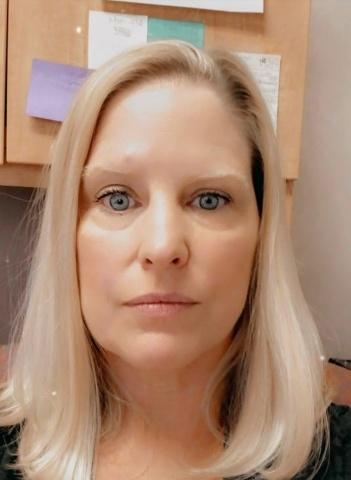
Karen White Tong first came to our EMG labs as a college sophomore, soon becoming fascinated with the neurological processes behind nerve conduction studies and with her interactions with patients. Now as a clinical research coordinator, she’s running a large clinical trial for patients with Parkinson’s disease and recruiting patients with spinocerebellar ataxia. For this week’s “Spotlight” interview, White Tong talks to us about developing long-term relationships with her patients, juggling work and parenting during the age of COVID-19, and her lifelong enjoyment of Duke football and basketball and the outdoors of North Carolina.
What are your current responsibilities within the Department? What does a typical day look like for you?
I am a CRC II (clinical research coordinator), and I am currently running a big Parkinson’s research trial with early Parkinson’s patients that have monthly infusions. I also have a spinocerebellar ataxia trial going on right now that I am still recruiting for. Recruiting for these studies involves a lot of phone calls, looking through medical records and going through extensive screening/consent processes. Typically my studies run 2 years, if not more.
Since I typically see my patients monthly for greater than 2 years, I feel like the patients and I get to know each other really well and we develop friendships that last far beyond when the studies have concluded. Each day for me starts with seeing my first patient of the day, usually starting at 8 am. My study visits can last anywhere from 1 hour to 4 hours so afternoons are usually spent going through all my data and entering it for sponsor perusal. I typically prepare for my study visits in advance and have appointments, paperwork, lab kits, etc all ready to go on visit days.
How has the COVID-19 epidemic affected your job and personal life? What’s one positive strategy or resource you’ve found that helps you cope?
So far, COVID-19 has not affected my job as my studies are considered essential and I have had every single patient come in for their visits since March. Personally, COVID has affected me much more on the home. In March, my daughter’s school went virtual and I had to juggle coming into work every day and staying home with her to make sure she did her virtual classes. We also didn’t go out to eat anymore or go to the movies. My daughter played soccer and that was canceled as well as spring/summer swim team. Luckily, I live in the country and can take walks in the woods with our yellow lab “Kula” or fish on our pond in order to get fresh air.
How and when did you first come to the Neurology Department?
I came to the Neurology Department when I was a sophomore in college here at Duke. I worked part time in the EMG Lab and eventually full time. I started working with Drs. Donald Sanders and Janice Massey. I was an EMG/NCS technologist and performed nerve conduction studies on patients. Doing this helped me learn about the various neurological disease processes and fascinated me.
What’s the biggest change in your work and at Duke in general since you first came here?
One of the biggest changes in my work since I came to Neurology is the number of patients I see on a daily/weekly basis. In the EMG Lab I saw up to 8 patients a day and now I see 1 to maybe 2 patients a day. I still know and work with a number of neurologists that I knew when I first started here at Duke.
What other passions or hobbies do you have outside of the Department?
I love going to see/watch Duke football and basketball games. I have been doing that since I was a child. I also love watching my daughter play soccer, which is mostly year long and I love watching her swim for her swim team in the spring and summer. I enjoy taking walks/hiking on our property in Hillsborough, we have miles of trails in the woods and a stream to wade in. We can also fish in the pond behind our house.